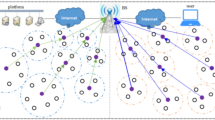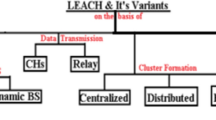Abstract
Using efficiently the wireless sensor networks based on IEEE 802.15.4/zigbee remains a real challenge for the forest fire detection and monitoring applications. The most relevant question is how we can maintain a long lifetime for the network with the need of fast and active sensor devices for the fire detection. In this paper, we propose a new approach Auto-organization, Adaptive frame Periods for forest Fire detection for multi-level optimization based on the network topology reorganization, and the frame activity period optimization according to the energy preservation and also the fire detection timing constraints. The reorganization is made locally according to the node states with regard to the fire detection events. It is made by a new association/re-association procedure that creates links and paths between nodes with respect to the two constraints. According to the network topology, an adaptive frame periods adjustment procedure is executed to select the suitable timing periods that reduce the sensor node activities without exceeding the timing constraints. The simulation results show superiority and efficiency of the proposed approach for the energy preservation, even if we consider a large network size.















Similar content being viewed by others
References
Forest Fire Lookout Page. http://www.firelookout.com. Last accessed August 2017.
Republic of Turkey. Ministry of Environment and Forestry, General Directorate of Forestry. http://www.ogm.gov.tr/. Last accessed August 2011.
Flannigan, M. D., Amiro, B. D., Logan, K. A., Stocks, B. J., & Wotton, B. M. (2006). Forest fires and climate change in the 21st century. Mitigation and Adaptation Strategies for Global Change, 11, 847–859.
Lee, B.-H. & Wui, H.-K. (2010). Study on a dynamic superframe adjustment algorithm for IEEE 802.15.4 LR-WPAN. In Vehicular Technology Conference (VTC). IEEE, May 2010.
Yick, J., Mukherjee, B., & Ghosal, D. (2008). Wireless sensor network survey. Computer Networks, 52(12), 2292–2330.
Doolin, D. M., & Sitar, N. (2006) Wireless sensor nodes for wildfire monitoring. In Proceedings of SPIE symposium on smart structures and materials, San Diego (pp. 477–484).
Yu, L., Wang, N., & Meng, X. (2005). Real-time forest fire detection with wireless sensor networks. In Proceedings of international conference on wireless communications, networking and mobile computing (WiMob) (pp. 1214–1217).
Kim, J., Lin, X., & Shroff, N. B. (2010). Minimizing the delay and maximizing lifetime for wireless sensor networks with anycast. IEEE/ACM Transactions on Networking, 12(2), 515–528.
Ganesh, U. A., Anand, M., Arun, S., Dinesh, M., Gunaseelan, P., & Karthik, R. (2012). Forest fire detection using optimized solar—Powered zigbee wireless sensor networks. International Journal of Scientific and Engineering Research, 4(6), 586–596.
Zhang, J., Li, W., & Kan, J. (2008). Forest fire detection system based on a ZigBee wireless sensor network. Frontiers of Forestry in China, 3(3), 369–374.
Demin, G., Haifeng, L., Anna, J., & Guoxin, W. (2014). A forest fire prediction system based on rechargeable wireless sensor networks. In 4th IEEE international conference on network infrastructure and digital content (IC-NIDC).
Othman, F., Bouabdallah, N., Boutaba, R. (2008). Load-balanced routing scheme for energy-efficient wireless sensor networks. In IEEE GLOBECOM 2008, New Orleans, LA, USA, December 2008.
National Fire Danger Rating System (NFDRS). https://www.wrh.noaa.gov/sew/fire.php/olm/nfdrs.htm. Last accessed August 2017.
Hefeeda, M., & Bagheri, M. (2009). Forest fire modeling and early detection using wireless sensor networks. Ad Hoc Sensor Wireless Networks, 7, 169–224.
Aslan, Y. E., Korpeoglu, I., & Ulusoy, Ö. (2012). A framework for use of wireless sensor networks in forest fire detection and monitoring. Computers, Environment and Urban Systems, 36, 614–625.
Lloret, J., Garcia, M., Bri, D., & Sendra, S. (2009). A wireless sensor network deployment for rural and forest fire detection and verification. Sensor Nodes, 9(11), 8722–8747.
Kułakowski, P., Calle, E., & Marzo, J. L. (2012). Performance study of wireless sensor and actuator networks in forest fire scenarios. International Journal of Communication Systems, 26, 515–529.
Wenning, B., Pesch, D., Giel, A., & Gorg, C. (2009). Environmental monitoring aware routing: Making environmental sensor networks more robust. Telecommunication Systems, 43(1–2), 3–11.
Jeon, J., Lee, J. W., Ha, J. Y., & Kwon, W. H. (2007). DCA: Duty-cycle adaptation algorithm for IEEE 802.15.4 beacon-enabled networks. In Vehicular technology conference (VTC). IEEE, April 2007.
IEEE Std 802.15.4™-2011 (Revision of IEEE Std 802.15.4-2006), IEEE Standard for Local and metropolitan area networks—Part 15.4: Low-Rate Wireless Personal Area Networks (LR-WPANs), IEEE Computer Society, sponsored by the AN/MAN Standards Committee, September 5, 2011.
Lim, J. H. & Jang, B. T. (2008). Dynamic duty cycle adaptation to real-time data in IEEE 802.15.4 based WSN. In Proceedings of 5th IEEE communication, and networking conference (pp. 353–357) January 2008.
Neugebauer, M., Plnnigs, J., & Kabitzsch, K.(2005). A new beacon order adaptation algorithm for IEEE 802.15. 4 networks. In Proceeedings of the 2nd European workshop on wireless sensor networks (pp. 302–311). IEEE.
Al Kiyumi, R., Vural, S., Foh, C. H., & Tafazolli, R. (2015). A distributed sleep mechanism for energy-efficiency in non-beacon-enabled IEEE 802.15.4 networks. In IEEE 20th international workshop on computer aided modelling and design of communication links and networks (CAMAD).
Hai, L., & Vu, T. S. (2006). Collision probability in saturated IEEE 802.11 networks. In Australian telecommunication networks and applications conference (ATNAC), Australia, December 2006.
Ning, X., & Cassandras, C. G. (2010). Dynamic sleep time control in wireless sensor networks. ACM Transactions on Sensor Networks, 6(3), 1–37.
Cohen, R., & Kapchits, B. (2009). An optimal wake-up scheduling algorithm for minimizing energy consumption while limiting maximum delay in a mesh sensor network. IEEE/ACM Transactions on Networking, 17(2), 570–581.
Ferrari, M., & Pizziniaco, L. (2006). An adaptive scheme for active periods schedule in IEEE 802.15.4 wireless networks, ISWCS ‘06. In 3rd international symposium on wireless communication systems.
Park, P., Ergen, S. C., Fischione, C., & Sangiovanni-Vincentelli, A. (2013). Duty-cycle optimization for IEEE 802.15.4 wireless sensor networks. ACM Transactions on Sensor Networks, 10(1), 12.
Rasouli, H., Kavian, Y. S., & Rashvand, H. F. (2014). ADCA: Adaptive duty cycle algorithm for energy efficient IEEE 802.15.4 beacon-enabled wireless sensor networks. IEEE Sensors Journal, 14(11), 3893–3902.
Ruzzelli1, A. G., Schoofs, A., O’Hare, G. M. P., Aoun, M., & van der Stok, P. (2009). Coordinated sleeping for beaconless 802.15.4-based multihop networks. In International conference on sensor systems and software, S-CUBE 2009: Sensor systems and software (pp. 272–287).
IEEE-TG15.4. (2006). Part 15.4: wireless medium access control (MAC) and physical layer (PHY) specifications for low-rate wireless personal area networks (LR-WPANs). IEEE standard for information technology.
Alkhatib, A. A. A. (2014). A review on forest fire detection techniques. International Journal of Distributed Sensor Networks, Hindawi Publishing Corporation, Vol. 2014.
Wang, Q., Dapeng, W., & Fan, P. (2010). Delay-constrained optimal link scheduling in wireless sensor networks. IEEE Transaction on Vehicular Technology, 59(9), 4564–4577.
Akkaş, M. A., & Sokullu, R. (2017). An IoT-based greenhouse monitoring system with Micaz motes. International Workshop on IoT, M2M and Healthcare (IMH 2017).
Cunha, A., Koubâa, A., Severino, R., & Alves, M. (2007). Open-ZB: An open-source implementation of the IEEE 802.15.4/ZigBee protocol stack on TinyOS. In IEEE international conference on mobile adhoc and sensor systems.
Oliveira, C. H. S., Ghamri-Doudane, Y., & Lohierh, S. (2013) A duty cycle self-adaptation algorithm for the 802.15.4 wireless sensor networks. In Global information infrastructure symposium. IEEE.
Silicon Labs. ETRX3 Series ZigBee Module AT-Command Dictionary, Telegesis™ is a trademark of Silicon Laboratories Inc., AT Command Manual November 2015 (Rev 3.09).
Stankovic, J. A., Spuri, M., Ramamritham, K., & Buttazzo, G. C. (1998). Deadline scheduling for real-time systems. Dordrecht: Kluwer Academic Publisher.
Tindell, K., & Clark, J. (1994). Holistic schedulability analysis for distributed hard real-time systems. Microprocessing and Microprogramming, 50, 117–134.
Audsley, N., Burns, A., Davis, R. I., Tindell, K. W., & Wellings, A. J. (1995). Fixed priority preemptive scheduling: An historical perspective. Real-Time Systems, 8(2/3), 173–198.
Audsley, N. C., Tindell, K., & Burns, A. (1993) The end of line for static cyclic scheduling?. In 5th Euromicro works. on real-time systems.
Hu, M., Luo, J., Wang, Y., Lukasiewycz, M., & Zeng, Z. (2014). Holistic scheduling of real-time applications in time-triggered in-vehicle networks. IEEE Transactions on Industrial Informatics, 10(3), 1817–1828.
Tindell, K., Burns, A., & Wellings, A. J. (1995). Calculating controller area network (can) message response times. Control Engineering Practice, 3(8), 1163–1169.
Mary, G. I., Alex, Z. C., & Jenkins, L. (2013). Response time analysis of messages in controller area network: A review. Journal of Computer Networks and Communications, 2013, Article ID 148015, 11 pages.
Kumar, A., Altman, E., Miorandi, D., & Goyal, M. (2005). New insights from a fixed point analysis of single cell IEEE 802.11 wireless LANs. In Proceedings of INFOCOM (pp. 1550–1561).
Texas Instruments CC2420 2.4 GHz IEEE 802.15.4 / ZigBee-ready RF Transceiver (2008). http://www.ti.com/lit/ds/symlink/cc2420.pdf.
Sung, W.-T., & Tsai, M.-H. (2012). Data fusion of multi-sensor for IOT precise measurement based on improved PSO algorithms. Computers and Mathematics with Applications, 64(5), 1450–1461.
Medagliani, P., Martalò, M., & Ferrari, G. (2011). Clustered Zigbee networks with data fusion: Characterization and performance analysis. Ad Hoc Networks, 9, 1083–1103.
Jurdak, R., Ruzzelli, A. G., & O’Hare, G. M. P. (2010). Radio sleep mode optimization in wireless sensor networks. IEEE Transactions on Mobile Computing, 9(7), 955–968.
Eklund, P. W. (2001). A distributed spatial architecture for bush fire simulation. International Journal of Geographical Information Science, 15, 363–378.
Tymstra, C., Bryce. R. W., Wotton, B.M., & Armitage, O. B. (2010) Development and structure of Prometheus: The Canadian Wildland fire growth simulation model, Inf Rep NOR-X-417. Natural Resources Canada, Canadian Forest Service, Northern Forestry Centre, Edmonton, Alberta, Canada (pp. 1–102).
Ayoub, Z. T., Ouni, S, & Kamoun, F. (2012). Energy consumption analysis to predict the lifetime of IEEE 802.15.4 wireless sensor networks. In 3rd international conference communications and networking (ComNet).
MICAz Wireless Measurement system, Document Part Number: 6020-0060-04 Rev A, Crossbow Technology, Inc. http://www.openautomation.net/uploadsproductos/micaz_datasheet.pdf, 2010.
Shuaib, K., Alnuaimi, M., Boulmalf, M., Jawhar, I., Sallabi, F., & Lakas, A. (2007). Performance evaluation of IEEE 802.15.4: Experimental and simulation results. Journal of Communications, V2(4), 29–37.
Author information
Authors and Affiliations
Corresponding author
Rights and permissions
About this article
Cite this article
Ouni, S., Trabelsi Ayoub, Z. & Kamoun, F. Auto-organization approach with adaptive frame periods for IEEE 802.15.4/zigbee forest fire detection system. Wireless Netw 25, 4059–4076 (2019). https://doi.org/10.1007/s11276-018-01936-x
Published:
Issue Date:
DOI: https://doi.org/10.1007/s11276-018-01936-x




